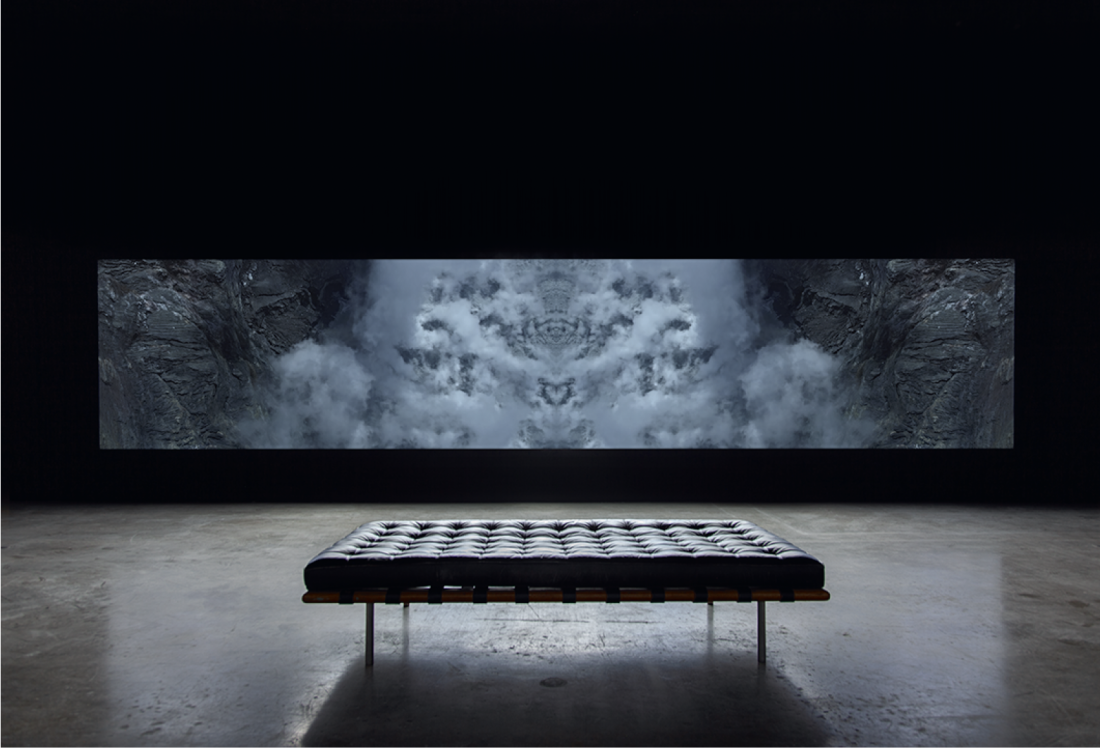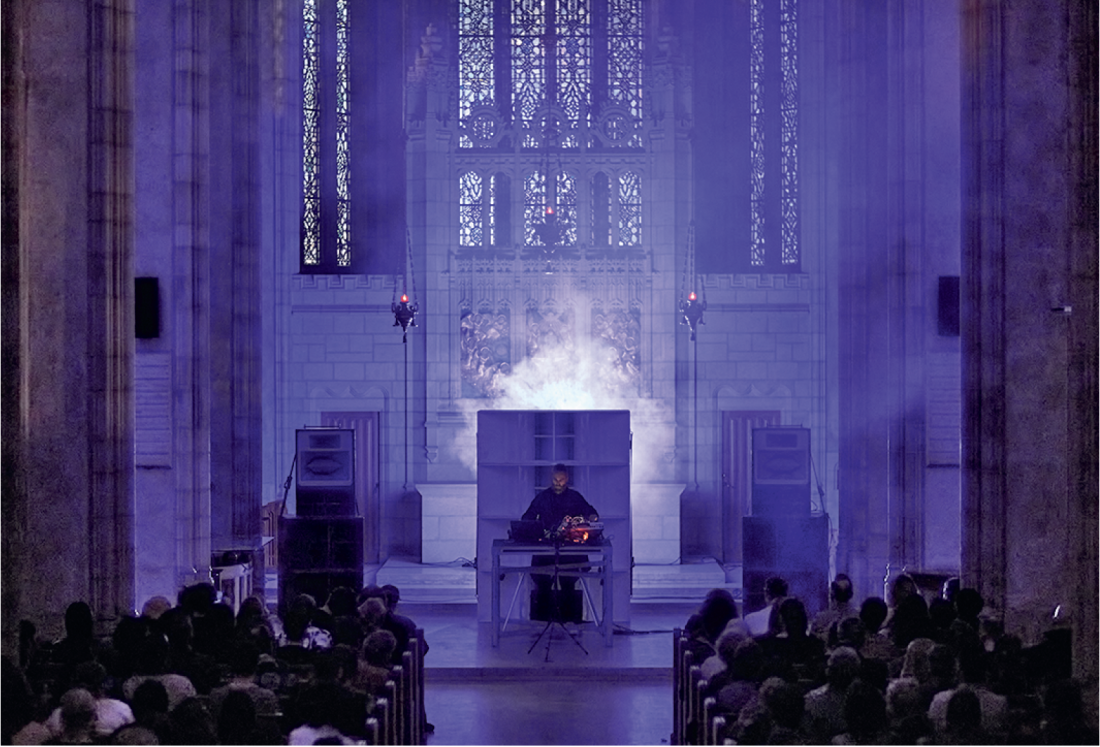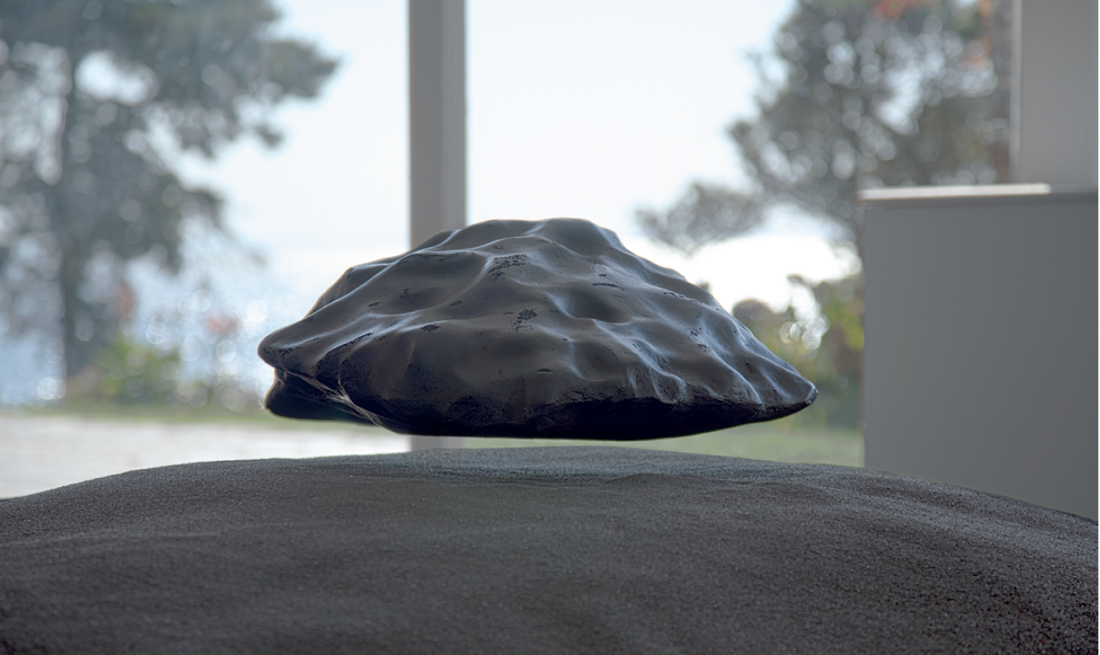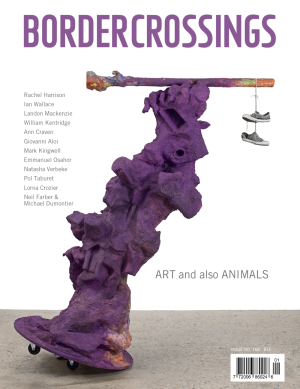Charles Stankievech
Time and space are expanded while simultaneously collapsed, as they always are, in the work of renowned Canadian artist Charles Stankievech recently on view in the exhibition “The Desert Turned to Glass” at Oakville Galleries. In it, multimedia works, collected research objects and site-specific installations are presented across the galleries’ two sites, which include Gairloch Gardens, a repurposed historic home located on the shoreline of Lake Ontario, and Centennial Square, a more traditional gallery space, set in the city’s downtown. Combined, the galleries present rich fieldwork as refined research-creation, where Stankievech’s seeming obsession with forces like meteorites take shape as powerful ecological ontologies that are ongoing, as well as bygone. Here, meteorites serve as overarching exhibitionary frameworks for rich material investigations of vast ecological relations and cultural cosmologies. These site-specific objects that hit the Earth have expansive stories to tell—if we are willing to listen.

Charles Stankievech, The Eye of Silence, 2023, installation at Oakville Galleries, Oakville, 6K video 30 minutes with 7.1 audio. Photo: Jimmy Limit. Courtesy Oakville Galleries, The Vega Foundation and Studio Stankievech.
Stankievech’s work importantly reminds us that meteorites embody “material evidence of the origins of the universe” and of “the stars and failed planets,” where “our entire history is entwined with them, from creation to eventual extinction” (Art Gallery of Ontario interview with the artist, 2023). Working with meteorites for over 15 years, the artist describes them as talismanic. This kind of understanding and orientation is well known and documented within various Indigenous cultures across Turtle Island and beyond, many believing that meteorites are sacred living beings and thus convey important information, teachings and premonitions. Likewise, the sites in which Stankievech’s works engage speak to long-standing Indigenous sovereignties, diasporic migrations and settler-colonial occupations that allow us to think through geographies and cosmologies from diverse cultural perspectives. For instance, in the major video work called The Eye of Silence, 2023, produced by artist and curator Ala Roushan and the VEGA Foundation, atmospheric recordings of places like the Canadian Badlands in Alberta and Bonneville Salt Flats in Utah are compiled with documentation of other representative sites, including Icelandic and Japanese volcanoes and the Namibian desert. Begun during the COVID-19 pandemic—an acute time in which the entire world experienced interruption and threat—The Eye of Silence, in its 30-minute span, visualizes decisive events in the Earth’s evolutionary history. It moves from colonial logics of “prehistory,” reflected in representations of Hadean-eon geological formations, to ancient petroglyphs and cave paintings, to more recent contexts and critical understandings of cultural practices and contemporary planetary life. Other key works include the titular Desert Turned to Glass, 2012–2023, an installation composed of a floating meteorite that hovers above a pile of volcanic sand, and a new series of glass sculptures, cast in the form of historically important meteorites, that were hand-blown using desert sand originally melted in 1945 during the first nuclear explosion at Trinity, New Mexico. In a work newly commissioned by the gallery, a video portrays a starfield as it transforms into a meteorite, coupled with a soundtrack composed of electromagnetic field recordings made on-site in Oakville during the 2024 solar eclipse. Further research materials on display include two-dimensional tectonic studies, which augmented the three-dimensional sculptures and richly immersive installations; all of which recreated meteorite encounters with “dark matter” and “deep space.” Dark matter is a component of the universe whose presence is discerned from its gravitational attraction rather than its luminosity, and is therefore mysterious, invisibly affecting and shaping the cosmos. Deep space is well outside the earth’s atmosphere, beyond the limits of the solar system, sometimes referred to as “interstellar” or “intergalactic” space. In re-presenting this range of “evolutionary fieldwork,” the exhibition invites us to think with and through time and space. Even the exhibition’s titling references mystical and magical processes of transformation, specifically when extreme heat turns sand particles into glass, such as occurs from lightning or meteorite impact in the desert. Today, desert glass is found in various places around the globe, such as Libya, eastern parts of the Sahara and the Namibian desert, which figure in Stankievech’s video.

Charles Stankievech, The Glass Key (Sanctuary), 2024, site-specific live performance with modular synth and organ at Trinity College Chapel, Toronto. Photo: Harry Choi. Courtesy Studio Stankievech.
Like the global sitings Stankievech investigates and puts in relation, his work has been shown to broad international audiences, in galleries and biennales all over the world, disseminating a unique comparative history of global presence and extinction that implicates us all. Seeing these works at Oakville Galleries has particular meaning to me, as someone who grew up and lives on treaty lands adjacent to Oakville (treaties 14 and 22). Gairloch Gardens’ location along the lake acutely reminds me of the ways in which diverse Indigenous communities have come to this place and have sustained themselves over time—most recently, the Anishinaabe, the Attawandaron and the Haudenosaunee. Today, the town of Oakville is located on/within the treaty lands of the Mississaugas of the Credit. Aside from territory, water is also acknowledged with gratitude in the Town of Oakville’s official land acknowledgement statement on their website, as being both “life” and “sacred.” Like the water that surrounds the exhibition’s Gairloch site, sound flows in relation to the work, through the form of a parallel event—an accompanying sold-out concert and experimental sound performance by Stankievech titled The Glass Key, held at Trinity College Chapel at the University of Toronto, where the artist works as an associate professor in the John H Daniels Faculty of Architecture, Landscape, and Design.

Charles Stankievech, Desert Turned to Glass, 2024, installation Oakville Galleries, Oakville. Photo: Jimmy Limit. Courtesy Oakville Galleries and Studio Stankievech.
Visitors to “The Desert Turned to Glass” experienced stratified ecosystems spread across two sites. As well, there were public events, including a discussion between the artist, Ala Roushan and writer and curator Séamus Kealy, which offered visitors layered meditations on origins, endings and infinity, through material and conceptual collisions of the cosmic, planetary and otherworldly. Indeed, Stankievech’s work leaves us with important questions related to world-making in past, present and future terms—relevant to all our relations. To me, its crux lies in its overarching exploration and provocation for other worlds— other worlds than this one in which so many of us struggle to live, where living well and responsibly is not only possible but also sustainable. ❚
“Charles Stankievech: The Desert Turned to Glass” was exhibited at Oakville Galleries, Oakville, from October 19, 2024, to February 1, 2025.
Ellyn Walker is an interdisciplinary arts scholar and curator based in Toronto, Treaty 13 territory.

